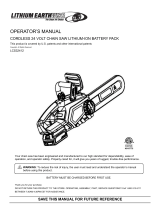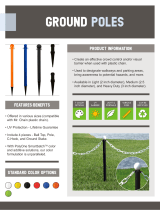Craftsman 358.341080 Owner's manual
- Category
- Power chainsaws
- Type
- Owner's manual
This manual is also suitable for
Craftsman 358.341080 is a powerful electric chain saw with a 12 Amp/3.75 HP motor and a 16-inch bar. It is a versatile tool that can be used for a variety of tasks, including felling trees, cutting logs, and pruning branches. The saw features a number of safety features, including a chain brake, a hand guard, and a low kickback chain. It also comes with a carrying case for easy transport and storage. With its powerful motor and durable construction, the Craftsman 358.341080 is a great choice for homeowners and professionals alike.
Craftsman 358.341080 is a powerful electric chain saw with a 12 Amp/3.75 HP motor and a 16-inch bar. It is a versatile tool that can be used for a variety of tasks, including felling trees, cutting logs, and pruning branches. The saw features a number of safety features, including a chain brake, a hand guard, and a low kickback chain. It also comes with a carrying case for easy transport and storage. With its powerful motor and durable construction, the Craftsman 358.341080 is a great choice for homeowners and professionals alike.
















-
 1
1
-
 2
2
-
 3
3
-
 4
4
-
 5
5
-
 6
6
-
 7
7
-
 8
8
-
 9
9
-
 10
10
-
 11
11
-
 12
12
-
 13
13
-
 14
14
-
 15
15
-
 16
16
Craftsman 358.341080 Owner's manual
- Category
- Power chainsaws
- Type
- Owner's manual
- This manual is also suitable for
Craftsman 358.341080 is a powerful electric chain saw with a 12 Amp/3.75 HP motor and a 16-inch bar. It is a versatile tool that can be used for a variety of tasks, including felling trees, cutting logs, and pruning branches. The saw features a number of safety features, including a chain brake, a hand guard, and a low kickback chain. It also comes with a carrying case for easy transport and storage. With its powerful motor and durable construction, the Craftsman 358.341080 is a great choice for homeowners and professionals alike.
Ask a question and I''ll find the answer in the document
Finding information in a document is now easier with AI
Related papers
-
Craftsman 358.341170 Owner's manual
-
Craftsman 358.341020 Owner's manual
-
Craftsman 358341161 Owner's manual
-
Craftsman 358.341040 Owner's manual
-
Craftsman 358341151 Owner's manual
-
Craftsman 358.341141 Owner's manual
-
Craftsman 358.341141 User manual
-
Craftsman 358.341180 Owner's manual
-
Craftsman 17234120 Owner's manual
-
Craftsman 358341190 Owner's manual
Other documents
-
Remington RM1035P Ranger II User manual
-
 EarthWise LCS32412 User guide
EarthWise LCS32412 User guide
-
Kobalt KCS 4040-06 Operating instructions
-
Kobalt KCS 4080-06 User manual
-
Shindaiwa MTA-PP/S User manual
-
Kobalt KCS 120-07 User manual
-
 Mr. Chain 95503 User manual
Mr. Chain 95503 User manual
-
Kobalt KCS 120-06 User manual
-
Simplicity MANUAL, LITHIUM-ION PRUNING SAW, 18V, VICTA User manual
-
Chicago Electric 67255 User manual

















